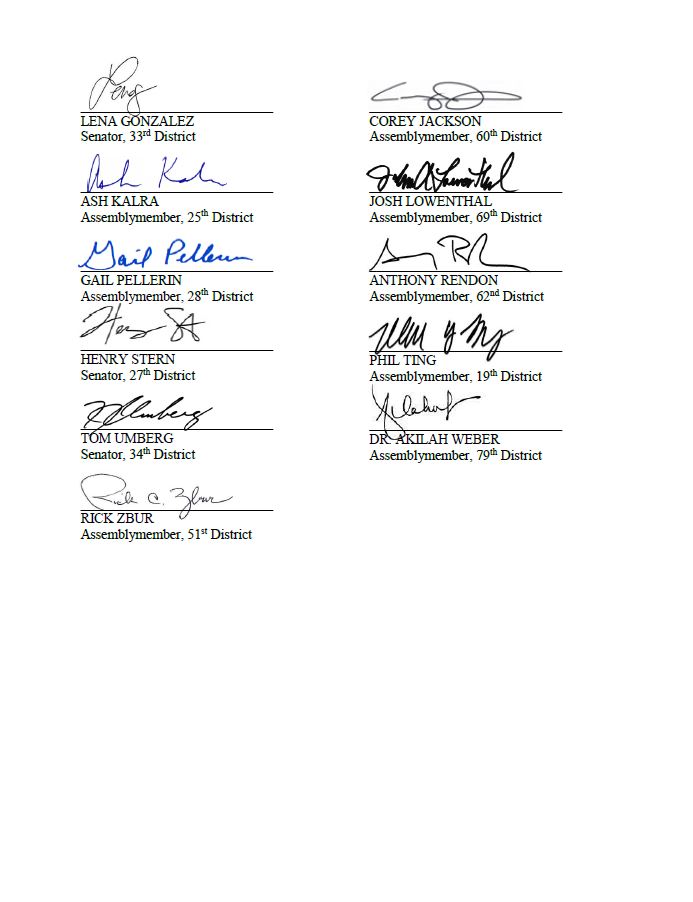July 16th, 2023
Charlton H. Bonham, Director
California Department of Fish and Wildlife
715 P Street
Sacramento, CA 95814
Eric Sklar, President
California Fish and Game Commission
715 P Street, 16th Floor
Sacramento, CA 95814
Dear Director Bonham and President Sklar,
As California lawmakers who are invested in the sustainability of California’s ocean health and climate-ready fisheries, we write to express our concerns regarding the types and rates of bycatch in the California set gillnet fishery targeting California halibut and white seabass. We urge the California Fish and Game Commission and the California Department of Fish and Wildlife to uphold the state’s commitment to protecting marine biodiversity by following the approach and criteria laid out in the federal Marine Life Management Act to promulgate comprehensive management measures to reduce bycatch in the California halibut and white seabass set gillnet fishery to acceptable levels. Doing so will support vibrant and sustainable fishing communities while protecting wildlife.
The condition of oceans is overwhelmingly important to Californians, both for quality of life and the economy. California’s robust marine economy generated $51.6 billion in Gross Domestic Product in 2019 – the second highest GDP of all 30 coastal states. California has a long history of regulating the set gillnet fishery to reduce bycatch and prevent negative impacts on the marine environment and protected species. Set gillnets were first banned off northern California as early as 1915. Due to bycatch concerns, California voters banned this gear type within southern California inshore waters via a 1990 state ballot proposition, and set gillnets were banned off central California by the California Fish and Game Commission in 2002. Nevertheless, this small fishery currently operates with little oversight in the biologically diverse ocean waters off southern California. Addressing this fishery’s impacts on biodiversity is timely on the heels of action by a California delegation to protect biodiversity at the December 2022 United Nations negotiations.
Federal observer data from NOAA Fisheries indicates the California set gillnet fishery discards 64 percent of the fish and other animals caught in the nets — among the highest discard rates in the nation. More than half of these discards are already dead, which is not only wasteful but raises sustainability concerns for a number of vulnerable species. More than 125 species of ocean animals are caught, including ecologically important sharks, rays, sea lions, dolphins, whales, and seabirds. These high rates of bycatch reflect poorly on California’s fishing communities and its reputation as a provider of sustainable seafood.
Due to the documented take of large whales (including humpback and gray whales), NOAA Fisheries lists California set gillnet fishery as a Category II fishery under the federal Marine Mammal Protection Act. California has taken strong action to prevent whale entanglements in other fisheries, such as drift gillnets and Dungeness crab.
We are committed to supporting and strengthening sustainable California fishing communities. Notably, set gillnets disproportionately affect marine species relative to hook-and-line gear – a more selective, lower-impact method to commercially and recreationally catch halibut and white seabass. Only 39 estimated active set gillnet permits exist, and 87 percent of California halibut commercial fishers already use hook-and-line gear. Additionally, set gillnets catch undersized halibut, which are discarded dead with impacts to commercial and recreational anglers who target halibut with cleaner gear types.
As stewards of healthy oceans, we are grateful to the Commission and the Department for prioritizing the management of set gillnets off the California coast. If legislative changes or funding is needed, we stand by, ready to help.
Sincerely,



